
Meet three alumni who turned challenging life experiences into full-fledged organizations working to change the world.
- By
- January 10, 2017
- Social Impact

When he arrived on vacation in Italy in 2011, Sam Porritt, ’86, was looking forward to a week of wine tasting and exploring Tuscany. But his attempt to photograph the first sunrise from the Tuscan villa where he was staying changed his life.
Porritt lost his footing and tumbled off a 15-foot wall after taking the photo with his phone. “I took a step and there was nothing under my foot,” he recalled. The fall injured his spinal cord and paralyzed him from the waist down.
After two hours on the ground, he was flown via helicopter to an Italian hospital for emergency surgery. He arrived back in the United States nearly three weeks later. Back home in Kansas City, Kansas, he learned what life was like in a wheelchair. Doctors weren’t sure whether he’d ever walk again.
The path to recovery was slow and uncertain. Over the course of two years, Porritt endured more than 400 sessions of physical therapy. Not only did he need to go through acute rehabilitation, he had to later focus on maintaining muscle mass and flexibility. The process was grueling, but today he is once again able to walk.
He credits his medical insurance policy’s coverage for physical therapy with helping him make a full recovery. When he arrived at outpatient rehabilitation, he learned that his insurance policy was among just 1 percent of plans without limits on pricey physical therapy sessions. Without insurance coverage to worry about, Porritt was able to concentrate on overcoming the incredible physical challenges he faced daily in rehab. “I went from using a wheelchair, to walking with a walker, to walking with crutches, to walking with a cane,” he said. “The rehab [process] was a very up-and-down emotional journey and there were many really tough days.”
For others going through the same rehabilitation process, however, recovery is painful financially as well as physically. As Porritt learned, virtually all other medical insurance policies include a so-called “therapy cap” of about 20–30 sessions of physical, occupational, or speech therapy, which is not nearly enough for patients working to recover from a catastrophic medical event such as a stroke, traumatic brain injury, or spinal cord injury. At every session, he witnessed fellow patients whose insurance benefits ran out and were sent home with permanent disabilities.
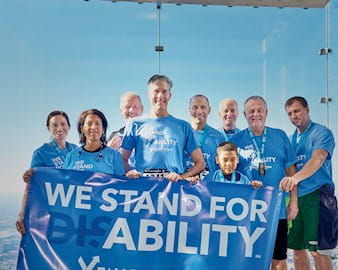
Porritt, who had previously worked in the corporate world, recognized the need for systemic change. His experience motivated him to found a nonprofit, the Falling Forward Foundation, to help other patients recovering from serious medical issues.
He’s part of a growing cohort of Booth alumni eager to merge their own life experiences with a mission to do good and the desire to achieve change in a big way. Alumni and students are increasingly turning to Booth to gain expertise in social innovation and to share their own successes in nonprofit leadership, said Christina Hachikian, AB ’02, MBA, ’07, adjunct assistant professor of strategy and executive director of the Social Enterprise Initiative (SEI) at Booth. The five-year-old initiative provides students, alumni, and faculty with valuable tools to pursue ideas that help solve social and environmental problems. The result is a quickly expanding community that’s led to a kind of cross-pollination of what it means to create and grow mission-driven enterprises. “We want alumni to see Booth as a source for them to fulfill their social impact interest,” said Hachikian. “There are lots of ways you can make an impact—from starting a new venture to being on a nonprofit board—and no one way is better or worse than another.”
As a student at Booth in the 1980s, Porritt wasn’t focused on following a path to nonprofit work, “but my thinking has changed in 30 years,” he admitted. The former retail marketer is now working to help those whose recoveries have suffered due to insurance limitations. Falling Forward donates money to rehabilitation centers and allows the centers’ therapists to dole out much-needed funds to patients whose insurance benefits run out before they have achieved a full recovery.
“I was going five times per week and recovering at a faster rate than patients only going twice per week. I was the lucky one.”
— Sam Porritt
Ultimately Porritt, who is based in Kansas City but works with centers around the country, wants to influence a policy change, especially around the issue of therapy caps. First imposed on Medicare patients when Congress passed the Balanced Budget Act of 1997, the caps were intended to address rising health-care costs. Commercial insurance companies followed suit. Today, Falling Forward is among a coalition of health-care associations and other advocates calling for such caps to be eased or eliminated so that patients aren’t stranded without coverage or forced to dole out a limited number of sessions over time.
“I was going five times per week and recovering at a faster rate than patients only going twice per week,” said Porritt. “I was the lucky one.”
As a nonprofit founder who dreamt big and eventually achieved much of what he set out to do, Porritt is in good company. After Susan Axelrod, LAB ’70, MBA ’82, learned that her infant daughter, Lauren, had epilepsy, figuring out how to improve or even save her child’s life became her goal. But she ran up against little data on the topic, and found herself searching for ways to address the lack of research in the field while caring for her child. “After watching my daughter suffer seizure after seizure and witnessing the damage that was doing to her developing brain, I thought, ‘This is crazy. Nobody is challenging the status quo,’” she recalled. “One-third of epilepsy patients continue to have seizures despite treatment, and we have to change that.”
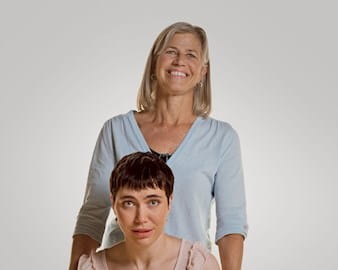
That demand for change helped spur Axelrod into action. She founded Chicago-based Citizens United for Research in Epilepsy, or CURE, in 1998, and remains founding chair. CURE promotes and supports research into the disease, much of which is still poorly understood. “We have grown from a patient/parent/loved-one grassroots effort into the major private funder of epilepsy research globally,” said Axelrod.
Building out the nonprofit wasn’t easy, and Axelrod was not certain at first how her formal business education would help shape an organization built out of passion and a dream. Though she filled many roles, she did not draw a salary, and getting the organization off the ground required abandoning some of the traditional principles of entrepreneurship. “I didn’t have a business plan,” she said. “I had a goal and a mission based on a deeply personal life experience, and that is what helped me to shape what we needed to do.”
“Sometimes our projects fail, sometimes they reap great rewards, but it almost always requires a long-term and significant investment to find out.”
— Susan Axelrod
CURE focuses on funding research that opens up and advances new avenues of discovery, with an average grant size of $250,000. For example, the organization was the first to fund research on sudden death in epilepsy, an area that—thanks to CURE’s seed grants—is now receiving more widespread attention and resources from government and other private sources. In general, scientific research “is an elusive thing to sell to people,” Axelrod said. “Sometimes our projects fail, sometimes they reap great rewards, but it almost always requires a long-term and significant investment to find out.” That can make fundraising a challenge, Axelrod said, so CURE has developed a rigorous scientific review process that helps them make the best use of donors’ gifts.
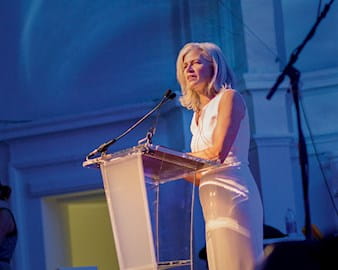
These days, a staff of 15 handles everything from fundraising—CURE has raised nearly $50 million to date—to evaluating and managing research strategies and projects. Axelrod said her education at Booth, where she had a concentration in healthcare, helped give her the ability to step back and look broadly at a situation, identify a need or an opportunity, and then evaluate and redirect as needed. Axelrod graciously gives back to the Booth community: on April 7, she’s delivering the keynote address at SEI’s On Board conference on nonprofit board service in Chicago.
“This has been an amazing and fulfilling experience that has brought people together from all walks of life—those whose lives have been touched, as well as scientists and clinicians who are professionally invested in the field of epilepsy—all with the singular focus of putting an end to epilepsy.”
Booth students are also making contributions to important social impact issues. A few years ago, SEI started working with the school’s Net Impact group—a chapter of the national student group—to support the group’s Board Fellows program. Board Fellows offers students a glimpse into the realities of sitting on the board of a nonprofit. And the program is now one of the most popular student-group initiatives at Booth.
As new students participate in SEI’s programs—including the John Edwardson, ’72, Social New Venture Challenge, the school’s venture-launch competition for social start-ups—their goals have become more focused, Hachikian said. There is a growing number of students with social impact ambitions, and by the time they are in business school, students are “tuned in” to problems across the globe and looking to get involved or start their own venture. That’s because students start to think about the ways they can make a difference in the world during their high school years—going way beyond more traditional community-service work. “Students are now more interested in having an impact on the world,” Hachikian said. She thinks it could be a result of greater awareness of social problems, or a decrease in faith in government to address these issues, or even a reaction to increasingly competitive college admission standards.
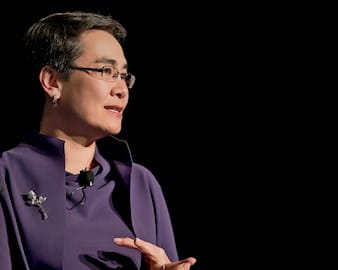
In her leadership courses, clinical professor of managerial psychology Linda E. Ginzel uses examples of nonprofit executives to teach her MBA students about influence. “Nonprofit executives have to be daring about gaining commitment,” she said. “They are experts at harnessing passion and getting people to give their heart and energy to their cause.” For executives who want to inspire their employees and influence change, learning from nonprofit management can be especially effective because they get an inside view of how to effectively practice leading organizations that aspire to big changes with lean budgets, she added.
Another benefit of bringing the nonprofit world into the classroom is that it shows how executives demonstrate ethical decision making. “Most of our decisions have an ethical component, whether we [recognize] it or not,” Ginzel said. The transparency of many nonprofit entities can be a prime example for learning about ethical decision making, she said.
When it comes to social impact issues, Ginzel draws upon her own personal experience too. In 1998, Ginzel and her husband, University of Chicago psychology professor Boaz Keysar, founded Kids In Danger, a nonprofit focused on the safety of children’s products, after a heartbreaking incident in which the couple’s 16-month-old son was strangled in a childcare facility due to a faulty crib that had been recalled. Ten years after Ginzel and Keysar started working toward changing federal legislation for children’s products, the Danny Keysar Child Product Safety Notification Act, a key portion of the Consumer Product Safety Improvement Act, was signed in 2008. The act requires strong standards for children’s products and ways for parents to learn about recalled products. While Ginzel is no longer involved in day-to-day operations, she still serves as president and member of the board. Today, Kids In Danger also participates in the Net Impact Board Fellows Program, allowing Booth students to become board fellows and suggest strategic decisions about the future of the nonprofit.
In addition to providing students with opportunities for social impact, Booth is increasingly becoming a resource for alumni looking to grow their nonprofit careers through continuing business education. The Harry L. Davis Executive Education Scholarship for Nonprofit Leaders program, launched in 2013, allows nonprofit executives to learn alongside for-profit executives. The handful of executives who get accepted each year can elect to take one of several weeklong leadership programs, Ginzel said.
The diversity they bring offers mutual benefits. “It’s not just nonprofit executives who benefit from learning from their for-profit counterparts; those in the nonprofit space bring valuable insight to the classroom,” Ginzel said. Executives can be inspired by the stories of mission-driven organizations that practice an essential skill: dealing with extreme uncertainty. “Once in a while you make a choice or decision to change the future [by going] to a place that doesn’t exist,” Ginzel said. Nonprofits “are all about their mission and know how to get people to rally around a cause.”
Alumni are also turning to Booth for the kind of expertise that can help them transition from the for-profit world to a focus on social impact. Each year, the Social Impact Leadership Series brings prominent speakers from the social sector to campus for discussion and networking sessions, helping to build a robust community with an interest in the sector. In 2015, Booth offered a Career Transitions program to help alumni develop a more concrete game plan for joining the world of nonprofits.
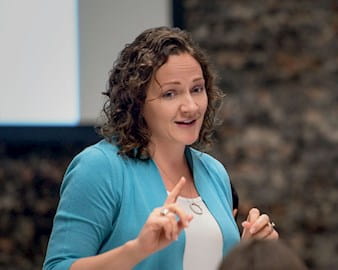
Also for alumni, SEI created the Alumni Board Connect program, which matches Booth graduates with nonprofit organizations to serve as directors of their boards. More than 100 alumni are now serving on nonprofit boards as a result of Alumni Board Connect. In addition to Chicago, the program is open to alumni in New York and the Twin Cities.
SEI’s programming is a way for alumni to see the business school as a source for ways to have a social impact in their current role or even to make a full-on career switch, said Hachikian. There’s not one right path to figuring out how you want to have an impact; it “sometimes happens five years out of business school or 35 years out of business school,” she said.
Booth is also expanding social impact on a global scale. SEI will operate the Hong Kong Jockey Club Programme on Social Innovation at the new University of Chicago Francis and Rose Yuen Center in Hong Kong. Made possible by part of a $30 million grant from the Hong Kong Jockey Club Charities Trust, the new programming will offer opportunities to enhance the social impact sector in Hong Kong and engage Booth students and alumni in Hong Kong and throughout Asia.
Without the kind of support that places such as SEI offer, starting a nonprofit or social enterprise after spending the bulk of one’s career in the corporate world can be a reality check, said Falling Forward’s Porritt. While Porritt works full time on the rehabilitation nonprofit, operating out of a home office is a change from his meeting-filled corporate days. “Honestly, that’s the really hard part of this,” he said. “I come from the for-profit world where you have staff budgets and resources.”
Recently Falling Forward partnered with the largest rehabilitation provider in the country, the Rehabilitation Institute of Chicago, to dispense funding for therapy for individual patients whose insurance benefits have run out. Since 2013, the nonprofit has funded therapy for 54 people with traumatic brain injuries, strokes, and spinal cord injuries. (The nonprofit does not make individual decisions regarding who needs therapy, but leaves that up to the discretion of providers, Porritt explained.) Ultimately, he hopes that the data Falling Forward gathers on recovery rates among patients they fund will push insurers to repeal some of the caps on rehabilitation, putting the treatment in a class with kidney dialysis or even chemotherapy. “We are building a dataset that shows that with additional rehab people can continue to recover,” he said.
“It’s important to balance your social outcome with your business outcome. You have to have metrics for the impact.”
— David Friedman
Part of that shift in thinking is a greater focus on the bottom line. Alumni and students looking to solve social problems are building mission-driven firms that also emphasize the bottom line, in the vein of “revenue-driven” nonprofits, said Hachikian. When it comes to creating viable businesses, it can be challenging to focus away from the traditional fund-raising model. For the founders, “there has certainly been an increasing focus on, ‘How are we going to effectively manage our financial stability?’” said Hachikian, who added that revenue now often comes from sales, not just generous donors.
David Friedman, ’89, who founded digital marketing agency AutonomyWorks, agrees. The former marketing executive founded the agency in Downers Grove, a suburb of Chicago, after considering the job prospects for his young autistic son. As his son grew older, Friedman realized there were few places where adults with autism could find meaningful work. During his son’s teenage years, Friedman—who spent 25 years in a more traditional business career, in marketing for Sears stores and Razorfish—knew he had to look more seriously into the problem. Autistic adults have an unemployment rate of nearly 80 percent, he said, even though many people on the autism spectrum are especially skilled at accurately carrying out a process that needs to be exactly the same every time. Friedman’s inspiration came partly from observing the distribution of newspaper circulars from his time at Sears. “My challenge was finding a business idea that fit with those talents,” he said.
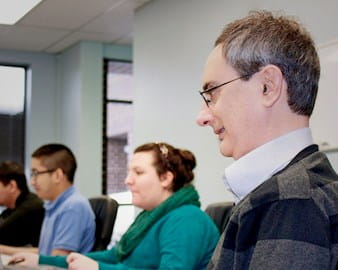
Unlike most other social-impact-venture founders, Friedman felt strongly against going the nonprofit route for his digital marketing firm. After learning about social enterprises through SEI, Friedman got the idea to form AutonomyWorks as a benefit corporation. The for-profit structure allows his employees to take a great degree of ownership of their careers, he said. Friedman wanted to create a business structure that takes into account the needs of the clients and ensures its viability in the marketplace. “It’s important to balance your social outcome with your business outcome. You have to have metrics for the impact,” he said.
Forging new paths takes time. Since setting up AutonomyWorks three years ago, Friedman said, he’s realized that building a company with a strong social-innovation component has felt like almost twice the work. He has had to be flexible in creating infrastructure for his employees to thrive, such as extra break space and the kind of schedule flexibility that’s atypical in a more traditional firm. “It’s a slower process than just setting up a company,” he said. “In addition to the normal problems with starting a business, it requires a certain level of innovation.”
The result is a digital marketing firm that focuses on repetitive tasks that need to be handled with precision. “Every ad you see on the internet gets put there by somebody—we do that,” he said. Friedman now employs approximately 30 people, including his 21-year-old son, who works at the firm part time and attends a nearby community college. All AutonomyWorks employees have autism except for a handful of executives in management roles.
Even as AutonomyWorks grows, Friedman keeps a careful focus on creating both a profitable business in the traditional sense and a model for other entrepreneurs in the space. “I want to stand up at the end of this and say we hired people with autism because they are better, and because they have unique skills,” he said.
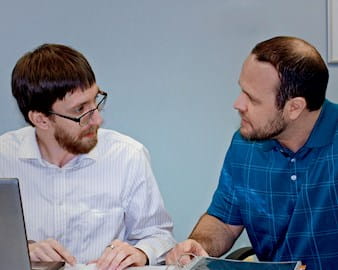
Though the business earns a return, there’s little focus on beating the competition among other autism-focused employment training organizations. Rather, Friedman refers to AutonomyWorks as “an open source company” and helps companies interested in employing people on the autism spectrum to create viable businesses. With so many autistic adults out of work and more than half a million projected to enter the workforce by the end of the decade, there’s room for anyone who wants to get involved: “I want to use [the firm] as a platform for other companies to hire people with autism.”
For Friedman, as well as the other nonprofit founders, the goal is to create a lasting impact that goes well beyond what they’ve already achieved: “We want to catalyze change.”
We'd love to hear your Booth memories, stories, connections...everything.